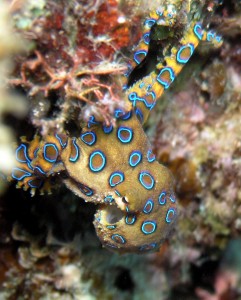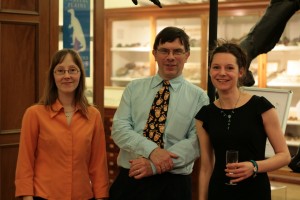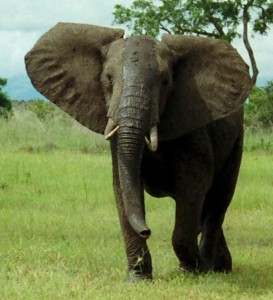MONDAY, 18 APRIL 2011
Deep inside the bodies of octopi, two different sorts of worm spend their lives drenched in octopus pee [1]. Both types of worm have a specialised head and body shape allowing them to embed themselves in the wall of the kidney and live the life of a perfect symbiont. At first glance the two sorts of worm look almost identical, but on closer inspection it is revealed that they are drastically different types of organism. One type of worm is called a dicyemid and is a multicellular animal whilst the other is a chromodinid, a single-celled protistan. The two worms come from very different parts of the biologists’ evolutionary tree and yet they are behaving in a remarkably similar manner. What is going on?Simon Conway Morris, Professor of Evolutionary Palaeobiology in the Department of Earth Sciences in Cambridge, believes that this is an example of convergent evolution. The central idea is that completely unrelated organisms evolve similar adaptations to specific problems because they experience similar environmental pressures. “Convergence is the observation that the same biological solutions are repeatedly reinvented” says Conway Morris.
It’s not just a few quirky examples either. “Convergence is ubiquitous” Conway Morris tells me, “evolution is very lazy: by and large if you’ve got a system that works you don’t throw it away.” He continues: “you tell me anything that has only evolved once and I’ll tell you it’s convergent.” “Even if the present evidence suggest it’s unique, I can show you parallels in other systems, which at the very least mean you ought to keep an open mind in this area” he asserts.
To help spread the word, Conway Morris and his team recently launched a website on convergent evolution called the ‘Map of Life’. “It’s a gigantic, interconnected encyclopedia of examples of convergent evolution” explains Dr Chloe Cyrus-Kent, who manages the project. The site presupposes a certain understanding of biology but it is intended to be both useful for academics and accessible to an intelligent lay audience. From the farming practices of leaf-cutter ants to gliding reptiles, the ‘Map of Life’ website is full of fascinating case studies.
Another classic example of convergence is the camera eye, which has evolved at least seven separate times within the evolutionary tree. When light enters our eyes, it must be focused onto our retina by a lens. However, the amount by which light is refracted when it passes through a lens varies depending on the path which the light has taken. A number of different groups have evolved the same solution: to vary the refractive index of the lens from its centre to its margin. Organisms also need an accommodation method so that they can see objects at different distances from their eye. This is usually done by changing the shape of the lens. What is strange, however, is that cubozoans, box-shaped jellyfish with no brain or optic nerve, also possess virtually identical camera eyes. As it says on the ‘Map of Life’ website, “camera eyes are superb optical devices, so it is not surprising that they have evolved several times - but why, of all animals, in the brainless jellyfish?” One suggestion is that they use their eyes to navigate safely among mangroves to find sunlit areas where their prey congregates.
Convergent evolution isn’t limited to physical structures. Take, for example the case of ‘colossal convergence’ between elephants and sperm whales. Both organisms have adopted matriarchal societies, where the adolescent males depart from the group to lead solitary lives. It would appear that even societal structures can be convergent. “It doesn’t matter whether you live in the ocean or in the trees, you’ve got the same sort of societal arrangement,” says Conway Morris.
I ask how the whole enterprise started. Conway Morris tells me how he interacted with evolutionary biologist Stephen J. Gould on the Burgess Shale, a particularly rich source of fossils. “At that time we thought the diversity of forms was such that there would be no predictability in outcomes”, he explains. Gould even came up with the famous metaphor that if you re-ran the ‘tape of life’ then everything would be different. But Conway-Morris now rejects this view. In fact, he now argues quite vociferously against it, including in his most recent book Life’s Solutions. “The number of options is much smaller than you might expect,” he says, “even though many biological solutions are complex, there are ultimately very few of them.”
Convergent evolution has also lead Conway Morris to form quite specific views about the possibility of extraterrestrial life. “As and when we meet an extraterrestrial I think I can basically tell you what it’s going to look like,” he says, “because the same solutions are going to be repeatedly invented on this as yet hypothetical planet.” But, as first pondered by the Italian physicist Enrico Fermi, if extraterrestrial life goes about things in a similar way to us, then why haven’t we heard from them yet? “I don’t think there are any extra-terrestrials at all,” admits Conway Morris, “I think the Fermi Paradox holds unfortunately - it’s ridiculous!”
There are plenty of critics concerned with certain inferences of convergent evolution. One particular argument they bring to the table is that of deep homology. They argue that the same gene is responsible for the development of a certain structure each time it appears in the tree of life. For example, in the case of the camera eye it has been claimed that a gene called Pax6 is always responsible. The underlying principle is that all animals share a suite of so called toolkit genes. However, Conway Morris rejects this as a stumbling block for convergent evolution. The way toolkit genes interact, are regulated and are required for completely new functions is what makes each animal group different. It is then after this has started occurring that convergent evolution is observed. For example, Pax6 is used by birds for making flight muscles as well as eyes. Pax6 alone isn’t enough to explain the seven separate generations of camera eyes.
Convergent evolution is gaining greater appreciation within mainstream biology and public understanding, and the ‘Map of Life’ website is another step in this direction. So next time you visit the zoo, compare your friends to those the other side of the bars. The similarities may be more than just coincidence.
Written by Tim Middleton




